London – While the coronavirus pandemic and the war in Ukraine have reaffirmed the importance of reliable journalism, the press has never faced so many challenges – and fake news is among the main ones.
Accusations of producing fake news, pressure to do more with fewer sources, and focusing on online engagement are some of the barriers that complicate journalists, according to a “State of the Media 2022” survey by distribution. platform. For the Cision press.
The company listened to more than 3,800 journalists from 2,160 vehicles across 17 global markets (excluding Brazil) to understand how journalism is facing rapid changes in the industry that increasingly demands the production of relevant content in a news cycle. less than 24 hours.
Fake news worries the world press
Essentially, the role of the journalist is the same as always: reporting the facts impartially and completely.
But in a media ecosystem transformed by social networks, competing for audience attention and creating increased polarization through them, most respondents reported that the biggest challenge for journalists was maintaining credibility as a reliable news source (32%) and tackling blame. He says the press produces “fake news”.
read it too
How does the polarization around trolls and science affect public knowledge?
To make matters worse for professionals, more than half (57%) of journalists surveyed think the public has lost confidence in the media in the past year – a 4% increase over Cision’s 2021 survey.
This is confirmed by the annual survey of the Reuters Institute for Journalistic Studies in Oxford. decline in public confidence in the news they receive.
Loss of confidence is highest among journalists in North America (61%), followed by those in Europe (55%).
But more than half (55%) of professionals in Asia-Pacific think media trust has not changed significantly over the past year. 14% think it has increased.
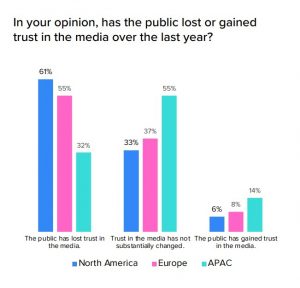
After the impact of fake news on the press, the second biggest issue cited by journalists is the impact on the daily routines of smaller teams and fewer sources, at 16%.
For the Cision platform, this reflects the efforts of professionals to keep up with the never-ending news cycle: nearly three in ten (29%) produce 10 or more stories per week; 36%, 4 to 9 articles per week; 34%, between one and three articles per week.
Not only do journalists cover multiple stories in a short amount of time, most journalists also cover multiple topics.
Almost half (44%) of journalists cover two to four topics; almost the same number (43%) covered five or more subjects.
read it too
Covid fake news ‘recycled’ for monkeypox, study shows
How does a decrease in income affect the press?
The third biggest challenge in journalism pointed out by professionals (16%) today is the decline in advertising revenues and print media circulation.
The decrease in available funds increases the demand for journalists to produce more, especially in the digital environment.
This leads many newsrooms and editors to keep a close eye on audience data.
The pressure to create clicks, shares, likes and video playbacks directly impacts the industry: 59% of journalists agree that the availability of detailed audience metrics is causing them to rethink how they decide what to publish or how to publish.
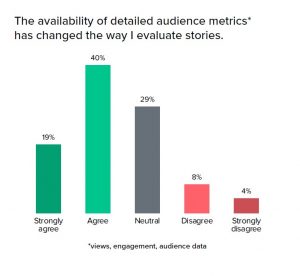
Other industry challenges by journalists are social networks and influencers who bypass traditional media (14%); the fine lines between editorial and advertising (10%), and attacks on freedom of the press (8%).
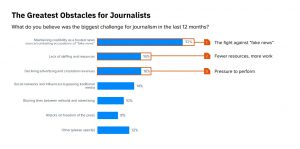
Media professionals in social media
In addition to the challenges, Cision’s research evaluated journalists’ engagement with social networks for the development of their work.
The majority (20%) said that social media is primarily used to post or promote content and then to engage with the audience (18%).
Third, 16% of journalists said that online platforms are used for networking, i.e. professional connections.
The same percentage (16%) said they use social media to monitor other organizations or find out what’s going on.
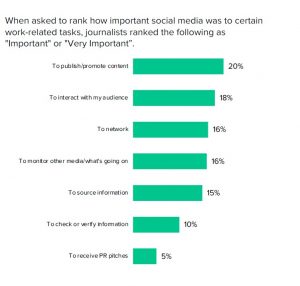
Worldwide, Facebook is the most frequently used platform by journalists for professional reasons (63%), followed by Twitter (59%) and LinkedIn (56%).
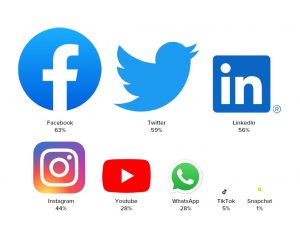
Surprisingly, if Facebook is the “sweetheart” network of media professionals, a regional segment shows that Twitter shares first place with Mark Zuckerbeg’s platform in North America and is linked to LinkedIn as the second most used platform in the world: European markets.
In the Asia-Pacific region, Instagram ranks second after Facebook, and journalists are as likely to use WhatsApp as LinkedIn.
WhatsApp is also more popular with journalists in Europe and Asia than in North America, where Telegram or iMessage are more commonly used for virtual messaging.
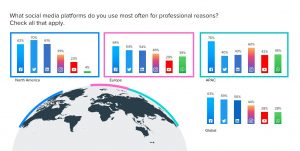
Cision’s research on journalism challenges also provides media professionals and public relations professionals with tips on best practices for approaching and advising media guidelines.
You can find the full text of the “State of the Media 2022” study here. connection.
read it too
source: Noticias
[author_name]

